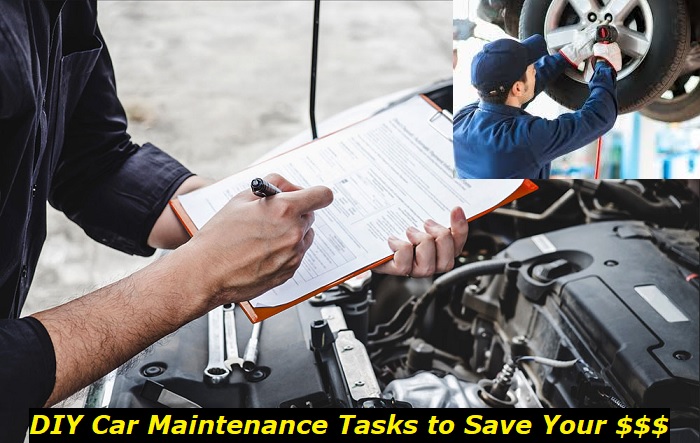The price of labor in repair shops and dealerships becomes extremely high. They may take $200 an hour and this makes your yearly maintenance unbearably expensive. I understand this can freak you out, so I decided to compile a list of maintenance tasks that you can easily do on your own without paying a cent to the dealers and repair shops.
Today, I will show you 10 DIY car maintenance tasks that you can do at home and prevent money from slippering out of your wallet. Yes, it can take some time to learn how to do some of them, but it's worth it! You can save thousands of dollars and also have fun by doing simple maintenance procedures and making sure they are done properly.

Let's get started!
1. Changing air filters
You may think that changing a filter is a hard task - even locating it may not be as easy as you would want. But with an engine air filter, things are different. While a dealer can take about $50 from you for this task, you can do it in 5 minutes in your garage.
For this, just do the following:
- locate the plastic filter box that is connected by the pipe to the throttle of the engine;
- figure out how you can open this box - usually, there are several latches on different sides;
- take out the old filter;
- clean the box with a soft cloth;
- take the new filter out of the carton box and make sure there is no plastic film on it;
- install the filter - usually, it shows arrows for the direction of its placement;
- close the plastic filter box with the latches.
That's all! You've just saved $50 and now your regular maintenance should cost you less money. Air filter replacement is recommended every year or once every 10K miles. Manufacturers usually set larger intervals, but the dust can clog the filter, so better change it more often.
2. Cabin filter replacement
This is another task that usually doesn't require any special knowledge or experience. All you need to do is to find a tutorial on Youtube on how this should be done in your car. Usually, you will need to unlatch a special box located under your glove box. While it may seem not really convenient, it's not that hard to do.
Then just take the old filter out and insert the new one in the same position.
This will take you another 10 minutes and will save you another $50 or even more, depending on the car model.
Changing your cabin filter is required once every 30,000 miles or 2-3 years. Again, I would do it more often because this lets you breathe clean and healthy air at all times.
3. Top off all fluids
This is a very important maintenance task that you should be doing on your own. At least once a week, you should check the level of all important fluids. Also, make sure you have a little engine oil, antifreeze, and brake fluid to top up if needed. You can't mix different types of fluids, so be careful!
Antifreeze is the easiest one. You will see the Min and Max lines directly in the reservoir. Keep the antifreeze level in the middle between these signs.
Brake fluid actually signals you that something is wrong, but the reservoir may also have Min and Max signs on it.
Engine oil is checked with the help of the dipstick. Take it out, wipe it with a tissue, put it back, and take it out again to check the oil level. Your vehicle should be placed on a level ground and the engine should be cold. The level of the oil should be somewhere in between Min and Max lines on the dipstick. Better keep it in the middle at all times.
Some transmissions also have dipsticks for checking the fluid level. Learn if yours has this and check it if you can.
4. Test and charge your 12V battery
The failure of the 12V battery is one of the most common reasons why you may not start your car one day. You can buy a really affordable multimeter specially designed for battery testing. Measure the battery voltage in different conditions and make sure it's always between 12 and 14 volts. If it falls lower than that, there is a problem with the battery.
If the battery is low, you can charge it. Buy a special car battery charger (they are also ridiculously affordable now) and maintain the battery. If you care about the car battery, it will live much longer and save you some money.
Anyway, remember that car batteries usually live up to 5 years. But the good news is that you can change the battery by yourself without going to the dealership and paying money. Just take the old battery off the vehicle and install the new one. In some cars, you will still need to go to the repair shop to code the new battery.
5. Replace the wiper blades
Just be careful to not break the fastening. But, in most cases, replacing the wiper blades take you just 5 minutes and doesn't require any knowledge or experience. You may watch a tutorial video before you go on because different vehicles have different types of fastenings. Though, in any case, replacing the blades is a quick and easy task.
6. Replacing the dead bulbs
Car manufacturers usually don't hide the light bulbs under too complicated fastenings, so you can easily replace almost all light bulbs and LEDs in your car. The only thing I wouldn't recommend touching is the headlight. The majority of modern vehicles have quite limited access to headlight bulbs and the type of light elements is always not that simple.
But all other light bulbs and LEDs are very easy to replace without any professional help. You may find a description of a light bulb replacement exactly for your vehicle model. After that, the job will take you 10 to 20 minutes and save you another $50 or even more.
7. Change the engine coolant
This is one of the most complicated things on my list, but there is nothing impossible about it. You will need to locate the drain plug in the engine and in the radiator. Place a plastic basin under your vehicle to catch all the old antifreeze. Slowly unscrew the plug in your radiator and drain the liquid into the basin. Then, unscrew the plug in the engine.
When the liquid is not flowing anymore, tighten both plugs and slowly pour the fresh antifreeze into your engine. There is no need to use water or some other chemical products to clean the system unless it's really dirty. Just add the fresh antifreeze to the coolant reservoir. Once you see that the reservoir is full, stop adding the coolant and start the engine.
Keep an eye on the level of antifreeze. It may go down a bit because the pump will deal with all air plugs in the system. Add some more coolant if it goes close to the Minimum line. Also, you will need to watch the coolant level for the next few days to add some coolant if needed.
8. Change the spark plugs and coils
While changing coils is pretty easy and straightforward, the plugs may have some issues with them. The most expensive tool you will need for this is the torque wrench because overtightening spark plugs may result in really fatal consequences for the thread in the engine head.
But still, you can borrow this tool from some acquaintance and do this job at no cost. Spark plug and ignition coil replacement in a good repair shop may cost about $200 and even more in a dealership.
9. Locate and deal with antifreeze leaks
In most cases, your coolant may leak because of a poor connection of pipes with some parts of the cooling system. After some time, plastic latches and other fasteners go bad and stop doing their job correctly. This means that you will need to replace them.
Also, some pipes may crack or be damaged by some other parts. You may easily replace these pipes if you know how to drain and add coolant to your vehicle (read above). Dealing with a coolant leak is very often easier than you may think.
10. Retorquing your wheel bolts or nuts
I recommend getting a torque wrench for your wheels and regularly checking whether they are torqued properly. Badly tightened wheel bolts may result in all kinds of different symptoms that will make you inspect the suspension, pay for wheel alignment, etc. But the first thing you need to check when this happens to your vehicle is whether the wheel bolts are tightened properly.
Using a torque wrench, it's pretty easy and straightforward to do that. Just learn what kind of torque should be in your wheel bolts.
Final thoughts
Although some of the maintenance procedures are obviously not good for DIYers, several repairs can be easily done on your own with zero costs (just some parts). If you start maintaining your vehicle by yourself, you will learn more about the car and maybe will also master some more complicated procedures like oil changes and even some repairs. Eventually, this will save you a lot of money.
But if you aren't sure how a certain process is completed, better go to specialists and let them do the job.
About the authors
The CarAraC research team is composed of seasoned auto mechanics and automotive industry professionals, including individuals with advanced degrees and certifications in their field. Our team members boast prestigious credentials, reflecting their extensive knowledge and skills. These qualifications include: IMI: Institute of the Motor Industry, ASE-Certified Master Automobile Technicians; Coventry University, Graduate of MA in Automotive Journalism; Politecnico di Torino, Italy, MS Automotive Engineering; Ss. Cyril and Methodius University in Skopje, Mechanical University in Skopje; TOC Automotive College; DHA Suffa University, Department of Mechanical Engineering






Add comment